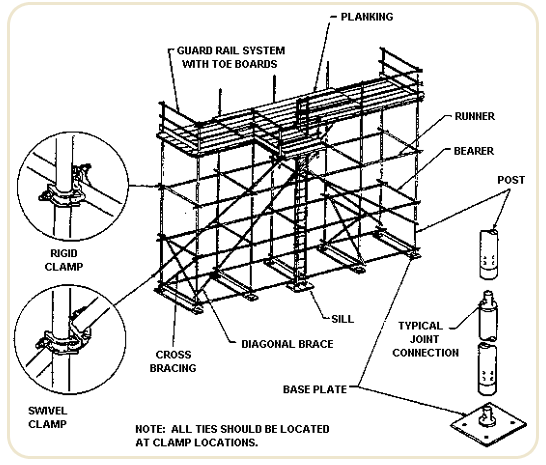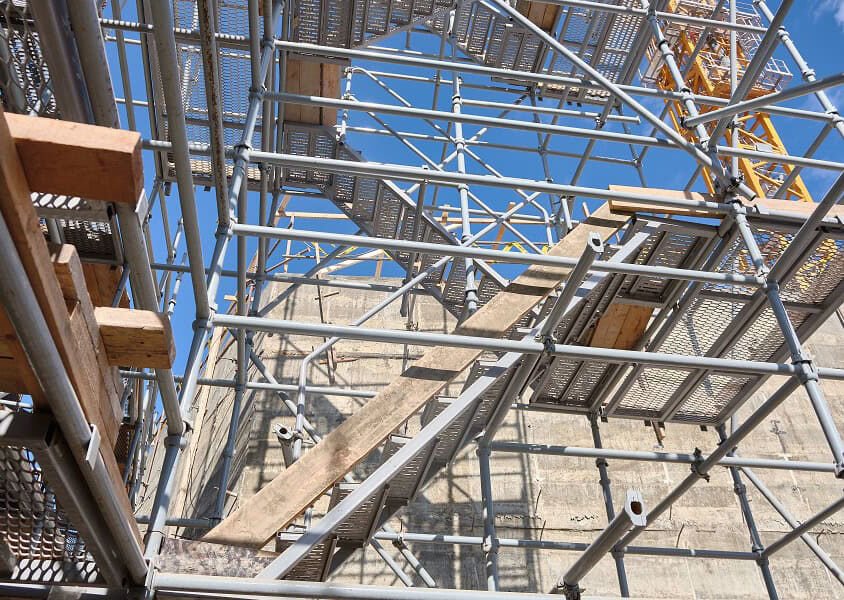Quality Scaffolding Surrey for Both Residential and Commercial Projects
Quality Scaffolding Surrey for Both Residential and Commercial Projects
Blog Article
A Comprehensive Guide to the Necessary Features of Scaffolding in Modern Building
The landscape of modern building progressively depends on reliable scaffolding systems that focus on efficiency, innovation, and security. As projects grow in intricacy, comprehending the vital features of scaffolding ends up being critical for making certain worker safety and security and maximizing project timelines. This guide discovers numerous kinds of scaffolding, highlights key safety functions, and analyzes product innovations that add to efficiency and sustainability. Nevertheless, the effects of these aspects prolong far past plain construction practices, triggering a closer look at how they influence overall task success and worker health.
Sorts Of Scaffolding
Although scaffolding systems can vary extensively in style and application, they usually fall under several distinctive categories that provide to various construction needs - Scaffolding. One of the most common kinds consist of supported scaffolding, suspended scaffolding, and rolling scaffolding
Sustained scaffolding contains platforms sustained by a framework of poles, which give a raised and secure functioning surface. This kind is commonly utilized for jobs that call for considerable elevation, such as bricklaying or external painting.
Put on hold scaffolding, on the other hand, is made use of for projects calling for accessibility to high altitudes, such as cleansing or repairing structure facades. This system hangs from one more structure or a rooftop, allowing workers to lower or elevate the platform as required.
Rolling scaffolding features wheels that enable for simple mobility throughout a work site. It is particularly useful for tasks that call for constant moving, such as indoor job in huge areas.
Each kind of scaffolding is designed with certain applications in mind, ensuring that building jobs can be executed successfully and successfully. Comprehending these classifications is crucial for choosing the appropriate scaffolding system to satisfy both job demands and site conditions.
Trick Safety Features
Safety is critical in scaffolding systems, as the possible risks related to functioning at elevations can lead to serious mishaps otherwise properly managed. Key safety and security functions are vital to guarantee the health of workers and the integrity of the building and construction site.
Primarily, guardrails are vital. These barriers give a physical protect versus falls, dramatically minimizing the risk of severe injuries. Furthermore, toe boards are frequently made use of to stop devices and materials from dropping off the scaffold, safeguarding employees below.
One more vital element is using non-slip surface areas on systems. This feature improves grasp, particularly in damaging climate condition, thereby minimizing the chance of slips and falls. Accessibility ladders should be safely positioned to assist in secure entry and exit from the scaffold.
Routine evaluations and maintenance of scaffolding systems are likewise critical. These evaluations make sure that all components remain in excellent problem and operating correctly, addressing any type of wear or damages promptly.
Lastly, proper training for all personnel associated with scaffolding procedures is vital to ensure that they understand security procedures and can determine prospective dangers. Scaffolding. Collectively, these functions create a safer working environment and considerably reduce threats connected with scaffolding
Product Technologies
Innovations in product science have actually substantially affected the scaffolding market, enhancing both safety and security and performance in modern-day building and construction. The introduction of high-strength steel and aluminum alloys has actually transformed traditional scaffolding systems. These products are not just lighter, making them easier to set up and deliver, however likewise give superior load-bearing capacities. This leads to scaffolding frameworks that can sustain higher weights while reducing the threat of collapse.
Additionally, ingenious composite materials, such as fiberglass-reinforced plastics, have actually emerged as viable options. These materials are immune you could try here to rust and environmental deterioration, thus expanding the life expectancy of scaffolding systems, specifically in severe climate problems. The usage of such products adds to decrease maintenance prices and makes sure constant performance over time.


Layout Considerations
Considering the complexities of modern-day construction projects, reliable scaffolding design is extremely important to guaranteeing both capability and safety. Design factors to consider must include numerous elements, consisting of load ability, height, and the particular needs of the construction website. Each task presents distinct obstacles, necessitating a flexible technique to scaffolding systems that can adapt to differing problems.
Architectural integrity is crucial; consequently, engineers should determine the lots that the scaffolding will sustain, including workers, products, and tools. The selection of products plays a vital duty in ensuring scaffold frames the scaffolding can endure these tons while continuing to be lightweight and long lasting. In addition, the layout needs to permit simple accessibility and egress, promoting the smooth activity of products and employees.
Safety and security attributes, such as guardrails and non-slip surface areas, should be integrated to lessen dangers of mishaps. important source The layout has to take into consideration the surrounding environment, including adjacent structures and possible hazards. By attending to these layout factors to consider, building companies can boost the performance of scaffolding systems and promote a much safer working environment, inevitably contributing to the overall success of the task.
Upkeep and Evaluations
The effectiveness of scaffolding systems expands beyond initial layout and application; ongoing upkeep and routine assessments are important to guaranteeing their proceeded performance and security throughout the duration of a project. Normal assessments should be performed by qualified employees to identify any indications of wear, damage, or instability that might jeopardize the stability of the scaffolding.
Maintenance methods ought to consist of regular checks of architectural elements, such as planks, structures, and fittings, making certain that all aspects continue to be totally free and secure from deterioration or various other wear and tear. In addition, the functionality of security features, such as guardrails and toe boards, need to be assessed to make certain compliance with security guidelines.
Documentation of all evaluations and upkeep tasks is essential for responsibility and governing conformity. A systematic method to record-keeping not only aids in tracking the condition of the scaffolding yet additionally provides required evidence in the event of an event.
Eventually, developing a thorough upkeep and examination schedule will dramatically lower the threat of accidents and enhance the overall security of the building and construction website. By focusing on these techniques, building and construction supervisors can safeguard workers and support the project's integrity.

Conclusion
In conclusion, the crucial functions of scaffolding in modern building encompass an array of important elements, consisting of diverse kinds, key security devices, material innovations, and thoughtful layout factors to consider. Emphasizing safety and security through guardrails and non-slip surface areas, along with innovations in products like high-strength steel, enhances both efficiency and sustainability. Furthermore, regular maintenance and inspections are essential for making certain structural honesty and safety on building and construction sites, eventually promoting reliable job implementation and advertising the well-being of employees.
The landscape of modern building progressively counts on reliable scaffolding systems that focus on technology, performance, and safety and security.Innovations in product scientific research have significantly influenced the scaffolding industry, enhancing both safety and security and performance in contemporary building and construction. On the whole, these product advancements not only improve the performance and security of scaffolding systems however likewise align with the industry's press in the direction of sustainability, as several modern-day products are created to be much more environmentally pleasant.
Taking into consideration the intricacies of modern-day building and construction jobs, effective scaffolding layout is extremely important to ensuring both functionality and security.In conclusion, the crucial attributes of scaffolding in contemporary building and construction include a variety of important elements, consisting of varied kinds, essential safety devices, material innovations, and thoughtful layout considerations.
Report this page